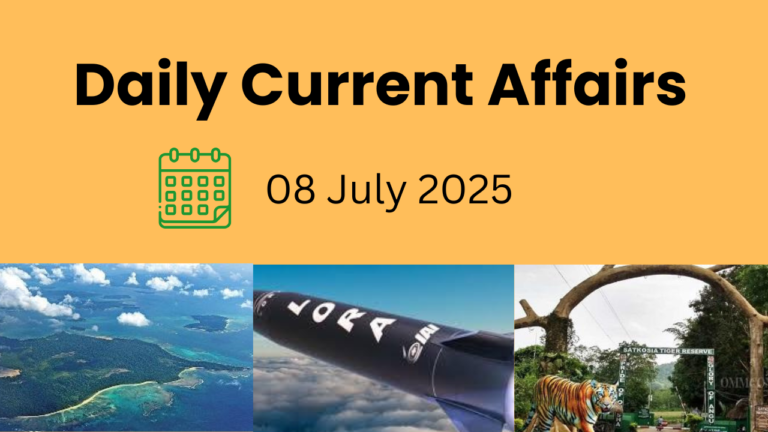1. e-NAM 2.0: Upgrading India’s Digital Agricultural Market
Context: The Union Agriculture Minister has announced plans to upgrade the National Agricultural Market (e-NAM) to e-NAM 2.0, aiming to resolve logistical challenges in inter-state and inter-mandi trade and enhance market efficiency.
What is e-NAM?
- Launched in 2016, e-NAM is a pan-India electronic trading platform that integrates Agricultural Produce Market Committee (APMC) mandis, creating a unified national market for agricultural commodities.
- Implemented by: Small Farmers Agribusiness Consortium (SFAC) under the Ministry of Agriculture & Farmers’ Welfare (MoA&FW).
- Key Features:
- Digital trading platform for farmers, traders, Farmer Producer Organizations (FPOs), and mandis.
- Seamless price discovery and online payments.
- Current Reach (as of Dec 31, 2024):
- 1,361 mandis across 23 states and 4 Union Territories.
- 1.79 crore farmers and 2.63 lakh traders registered.
- Facilitated trade worth 2.79 lakh crore.
Challenges in the Existing e-NAM System:
Despite its success, several bottlenecks remain:
- Logistical Issues: Inefficient transportation causes high transit times, affecting timely delivery.
- Inadequate Warehousing & Storage: Lack of proper storage facilities leads to post-harvest losses.
- Limited Digital Literacy & Internet Access: Many farmers struggle to use the platform due to lack of awareness and poor connectivity.
4. Interstate Trade Barriers:
- Variations in state APMC laws restrict smooth transactions.
- Different state tax & compliance norms create complexity.
Key Features of e-NAM 2.0:
1. Enhanced Logistics & Transportation Support:
- Unified Logistics Interface Platform (ULIP) for real-time tracking of produce.
- Optimized freight options to reduce transit time and improve delivery.
2. Expanded Warehousing & Cold Storage Infrastructure:
- Subsidized loans under the Agricultural Infrastructure Fund (AIF) to promote private investment in storage.
3. AI-Driven Price Discovery & Quality Assessment:
- Artificial Intelligence (AI) & Machine Learning (ML) for fair market price suggestions.
- Automated quality testing to minimize disputes over product grading.
4. Faster Digital Payments & Financial Support:
- Direct bank transfers & e-wallet integration for quick settlements.
- Fintech partnerships to provide micro-loans based on transaction history.
5. Simplified Interstate Trade:
- Unified digital pass to ease regulatory compliance.
- Standardized tax & compliance framework for smooth trade across states.
6. Mobile Accessibility & Vernacular Support:
- Voice-based commands and local language options in the e-NAM app.
- Digital literacy campaigns to train farmers in using the platform.
Expected Impact of e-NAM 2.0:
- Increased Farmer Participation: Easier access and better incentives will attract more farmers.
- Higher Price Realization: Direct market access will reduce middlemen, ensuring fairer prices.
- Reduced Post-Harvest Losses: Improved storage & transport infrastructure will cut wastage significantly.
- Boost to Logistics & Supply Chain Sector: Increased investments in agri-logistics will fuel economic growth.
Conclusion: The e-NAM 2.0 upgrade will transform India’s agricultural market by eliminating inefficiencies, boosting digital access, and ensuring fair trade opportunities for farmers. If implemented effectively, it can revolutionize agricultural commerce, making Indian farming more profitable and globally competitive.
2. India’s Gold Investments Surge 60% to 1.5 Lakh Crore in 2024
Context: According to the World Gold Council (WGC), India’s gold investments surged by 60% in 2024, reaching $18 billion (1.5 lakh crore) compared to 2023. This marks a significant rise in demand for gold as an investment and hedge against economic uncertainties.
Key Highlights of the WGC Report
- India’s gold investment demand: 239 tonnes in 2024 – the highest level since 2013.
- 29% increase from 185 tonnes in 2023.
- Global gold demand: Rose 25%, surpassing 945.5 tonnes in 2023.
- Growing interest in gold ETFs and mutual funds as alternative investment avenues.
Gold in India & Worldwide
- Gold accounts for over 5% of India’s total imports.
- Major gold reserves in India:
- Bihar (44%)
- Rajasthan (25%)
- Karnataka (21%)
- West Bengal & Andhra Pradesh (3% each)
- Jharkhand (2%)
- Major gold reserves globally:
- United States, Germany, Italy, and France.
Reasons Behind the Surge in Gold Investments:
1. Rising Gold Prices:
- Consistent increase in gold prices throughout the year.
- Investors see gold as a hedge against inflation and economic uncertainty.
2. Cultural & Festive Demand:
- Traditional preference for gold during weddings, festivals, and auspicious occasions.
- Higher retail demand significantly boosted gold purchases.
3. Urban Buying Trends & E-Commerce Growth:
- Increased gold-buying activity in metro cities.
- E-commerce platforms enabled easy investment in small gold bars and coins.
4. Weaker Performance of Other Asset Classes :
- Stock market volatility led investors to shift towards gold.
- Gold seen as a stable investment during uncertain economic periods.
Impact on the Indian Economy:
- Widening Current Account Deficit (CAD): Higher gold imports increase India’s trade imbalance.
- Inflationary Pressures: Surge in demand pushes gold prices higher, contributing to inflation.
- Financial Market Disruptions: More money moving into gold can reduce liquidity in equity markets, affecting stock market growth.
Way Ahead: Managing Gold Investments Efficiently
- Gold Monetization Schemes (GMS): Encouraging depositing idle gold in banks to reduce import dependence.
- Strengthening Gold ETFs & Mutual Funds: Offering tax incentives to promote digital gold investments.
- Expanding E-Gold Infrastructure: Fintech platforms to improve accessibility to digital gold investments.
About the World Gold Council (WGC):
- Established: 1987
- Headquarters: London
- Offices in: India, China, Singapore, UAE, and the USA.
- Governance: Led by a Board of Directors composed of member company representatives.
- Members: 32 global gold mining companies.
Conclusion: With gold demand reaching record highs, India’s love for gold as a financial and cultural asset remains strong. However, balancing imports, investment, and economic stability will be key for sustainable growth in this sector. Digital gold investments and monetization schemes could help manage demand while reducing the impact on India’s economy.
3. India Crosses 100 GW Solar Power Capacity – A Historic Milestone
Context: India has achieved a monumental milestone by surpassing 100 gigawatts (GW) of installed solar power capacity. This marks a major step in India’s journey towards a clean and sustainable energy future.
Unprecedented Growth in Solar Power:
- 35x growth in a decade – From 2.82 GW in 2014 to 100 GW in 2025.
- As of January 31, 2025, India’s total solar capacity stands at 100.33 GW, with:
- 84.10 GW under implementation
- 47.49 GW under tendering
- Rooftop solar boom – A 53% increase in 2024, with 4.59 GW of new capacity added.
- Top solar states – Rajasthan, Gujarat, Tamil Nadu, Maharashtra, and Madhya Pradesh.
- Massive expansion in solar manufacturing – From 2 GW in 2014 to 60 GW in 2024, aiming for 100 GW by 2030.
Why Solar Energy is a Game-Changer for India?
1. Energy Security:
- Reduces reliance on fossil fuels and imports.
- Helps India achieve self-sufficiency in power generation.
2. Environmental Benefits:
- Cuts greenhouse gas emissions, making India a leader in clean energy solutions.
- A key tool in combating climate change.
3. Economic Growth & Job Creation:
- Millions of new jobs in installation, maintenance, and manufacturing.
- Boosts India’s economy by strengthening the renewable energy sector.
4. Cost-Effectiveness:
- Solar energy is now cheaper than conventional electricity sources.
- Lower electricity bills for consumers and industries.
5. Rural Electrification:
- Brings power to remote and off-grid villages.
- Improves the quality of life for millions.
Government Initiatives Driving Solar Growth:
- National Solar Mission (NSM) (2010): Target: 280 GW of solar capacity by 2030.
- PM SuryaGhar Muft Bijli Yojana : Empowers homes with free rooftop solar power.
- PM-KUSUM Scheme : Supports solar-powered irrigation pumps for farmers.
- Solar Parks Scheme : Aims to develop large-scale solar parks across India.
- Production-Linked Incentive (PLI) Scheme : Encourages domestic solar panel manufacturing, reducing imports.
- Net Metering Policy : Allows consumers to sell surplus solar power to the grid.
- International Solar Alliance (ISA): A global solar energy initiative led by India to promote renewable collaboration.
Challenges Hindering Solar Expansion:
- Land Acquisition: Finding land for large-scale projects is a major hurdle.
- Grid Integration: Ensuring power stability while handling intermittent solar energy is a challenge.
- Financial Constraints: More investment needed in infrastructure & technology.
- Energy Storage Solutions: Affordable storage technology is crucial for uninterrupted power supply.
The Road Ahead – A Brighter Future for Solar in India:
With the right policies, technological advancements, and financial support, India is on track to become a global solar powerhouse. The next big goal – 280 GW by 2030 – will require sustained efforts, innovation, and investment.
India’s solar revolution has just begun, and the future looks brighter than ever.
4. RBI Cuts Repo Rate by 0.25% to Boost Economic Growth
Context: The Reserve Bank of India (RBI) reduced the repo rate by 25 basis points (bps) to 6.25%, marking the first rate cut since May 2020. The move is aimed at stimulating economic growth, aligning with the Union Budget’s 1 lakh crore income tax relief to boost urban demand.
- Inflation is expected to decline, creating space for monetary easing.
- GDP growth for 2025-26 is projected at 6.7%, an increase from 6.4% this year.
- The RBI continues with a neutral monetary policy stance, balancing growth support and inflation control.
Why Did the RBI Cut the Repo Rate?
Slowing Economic Growth & Need for a Boost:
- Economic growth has been losing momentum, prompting the government to use both fiscal (tax cuts) and monetary (rate cuts) measures to revive demand.
- Lower interest rates reduce borrowing costs, making home loans, car loans, and business loans cheaper, which can boost consumption and investment.
Inflation Remains Under Control:
- Projected inflation for Q1 2025-26: 4.5%.
- Since inflation is moderating and staying within the RBI’s target range (4% ± 2%), a rate cut was deemed appropriate.
Challenges & Risks to the Economy:
Global Uncertainties & Trade Risks:
- Geopolitical tensions, rising protectionist trade policies, and volatile commodity prices pose risks to economic stability.
- The RBI remains cautious but expects a gradual economic recovery.
Mixed Domestic Demand Trends:
- Rural demand is improving, but urban consumption is still sluggish.
- Factors like employment gains, tax relief, and stable inflation are expected to support household spending.
India’s External Sector & Forex Stability:
- The Rupee’s depreciation has been factored into RBI’s policy stance.
- The Current Account Deficit (CAD) remains within sustainable limits.
- Foreign exchange reserves stand at $630.6 billion, covering 10+ months of imports, ensuring economic resilience.
Understanding Monetary Policy Stances:
- Dovish: The RBI lowers interest rates to stimulate growth, making borrowing and investment more attractive.
- Hawkish: The RBI raises interest rates to control inflation, even if it slows economic expansion.
- Accommodative: The RBI maintains low interest rates and injects liquidity into the economy to support growth and employment.
- Neutral: The RBI takes a data-driven approach, adjusting interest rates based on economic conditions, without favoring growth or contraction.
With this rate cut, the RBI aims to revive growth while keeping inflation in check, signaling a shift toward a more supportive economic policy.
5. TROPEX 2025:a Indian Navy’s Largest War Exercise Underway
Context: The Indian Navy’s premier Theatre Level Operational Readiness Exercise (TROPEX) for 2025 is currently in progress in the Indian Ocean Region. This biennial mega exercise involves all operational units of the Indian Navy, along with substantial participation from the Indian Army, Indian Air Force (IAF), and the Indian Coast Guard.
TROPEX 2025 is designed to validate the Navy’s core warfighting strategies, ensuring an integrated and synchronized response to safeguard India’s maritime security interests. It focuses on countering conventional, asymmetric, and hybrid threats in an evolving maritime environment.
Duration and Phases: The exercise spans three months, from January to March 2025, and is divided into multiple phases, including:
- Harbour Phase – Focused on planning, coordination, and combat preparations.
- Sea Phase – Conducts real-time war drills, including cyber and electronic warfare operations and live weapon firings.
- Joint Work-Up Phase & Amphibious Exercise (AMPHEX) – Tests inter-service interoperability and amphibious assault strategies.
Massive Deployment of Warships, Submarines & Aircraft:
This year, TROPEX 2025 features a formidable naval force, including:
- 65 Indian Navy warships
- 9 powerful submarines
- 80+ aircraft of various types
The exercise involves cutting-edge platforms like:
- INS Vikrant (India’s indigenous aircraft carrier)
- Visakhapatnam & Kolkata-class destroyers
- Kalvari-class submarines
- MiG-29K fighter jets, P-8I surveillance aircraft, HALE Sea Guardian drones, and MH-60R helicopters
Integration of Indian Army, IAF & Coast Guard:
To enhance joint operations and synergy, the Indian Army, Air Force, and Coast Guard are actively participating, with:
- Sukhoi-30, Jaguar, C-130, AWACS, and Flight Refueller aircraft
- An Infantry Brigade with over 600 troops
- More than 10 Coast Guard ships and aircraft
Strengthening India’s Maritime DominanceOver the years, TROPEX has evolved into a high-intensity, complex exercise, reinforcing India’s ability to conduct precise, coordinated, and effective joint operations. TROPEX 2025 signifies India’s commitment to maritime security, ensuring readiness to defend national interests Anytime, Anywhere, Anyhow.
6. Baltic States Cut Energy Ties with Russia, Join European Grid
Context: The Baltic nations—Estonia, Latvia, and Lithuania—have officially disconnected from Russia’s electricity grid, marking the end of more than 30 years of reliance on the Soviet-era power system. This move is a major geopolitical shift, as the three countries now fully integrate into the European energy network.
Key Developments in the Transition:
- In 2024, Estonia, Latvia, and Lithuania notified Russia and Belarus of their plan to disconnect, preventing any unexpected escalations.
- Over the years, 16 power lines linking the Baltics to Russia and Belarus were dismantled in preparation for this move.
- To ensure a smooth transition, the Baltic nations developed new energy infrastructure, including underwater power cables in the Baltic Sea, connecting them to Europe’s energy network.
- The Kaliningrad region, a Russian exclave between Lithuania and Poland, has already been energy-independent, relying on its own power generation systems. Thus, the disconnection has minimal impact on the exclave.
Geopolitical and Strategic Significance:
- This move is a symbol of autonomy and resilience, highlighting the Baltic states’ determination to cut ties with Moscow after decades of uneasy relations.
- The decision is particularly significant amid ongoing tensions with Russia, especially after its invasion of Ukraine in 2022.
- By joining the European energy grid, the Baltic nations strengthen their energy security, ensuring full control over their power supply and reducing the risk of Russian energy manipulation.
The Baltic Nations: A Shift Towards Europe:
- The Baltic states—Estonia, Latvia, and Lithuania—are located in Northern Europe, along the eastern coast of the Baltic Sea.
- Formerly part of the Soviet Union, they declared independence in 1990 following the USSR’s collapse.
- Since joining the European Union (EU) and NATO in 2004, they have rapidly modernized their democratic institutions, economies, and infrastructure.
- Their focus has been on deepening integration with Western Europe, further distancing themselves from Russia.
Geographical Positioning of the Baltic States:
- Estonia is the northernmost, sharing borders with the Gulf of Finland to the north, Latvia to the south, and Russia to the east.
- Latvia lies between Estonia and Lithuania, with Russia to the east and the Baltic Sea to the west.
- Lithuania, the southernmost Baltic nation, borders Latvia to the north, Poland and Belarus to the south and east, and the Baltic Sea to the west.
A New Era of Energy Independence:
The Baltic nations’ disconnection from Russia’s power grid is more than just an energy shift—it is a bold statement of sovereignty and strategic independence. By fully integrating into the European energy system, Estonia, Latvia, and Lithuania ensure a stable, self-reliant, and secure future, free from Russian influence.




